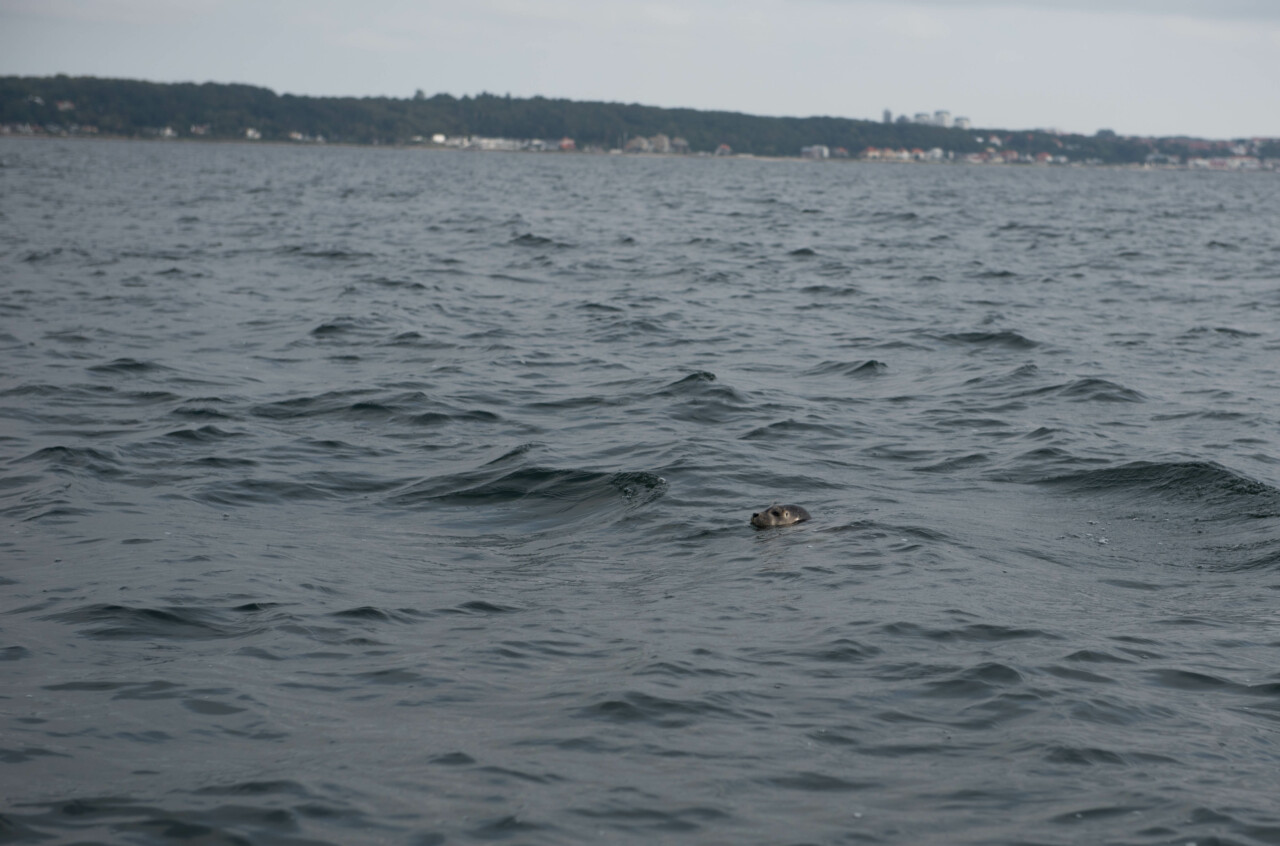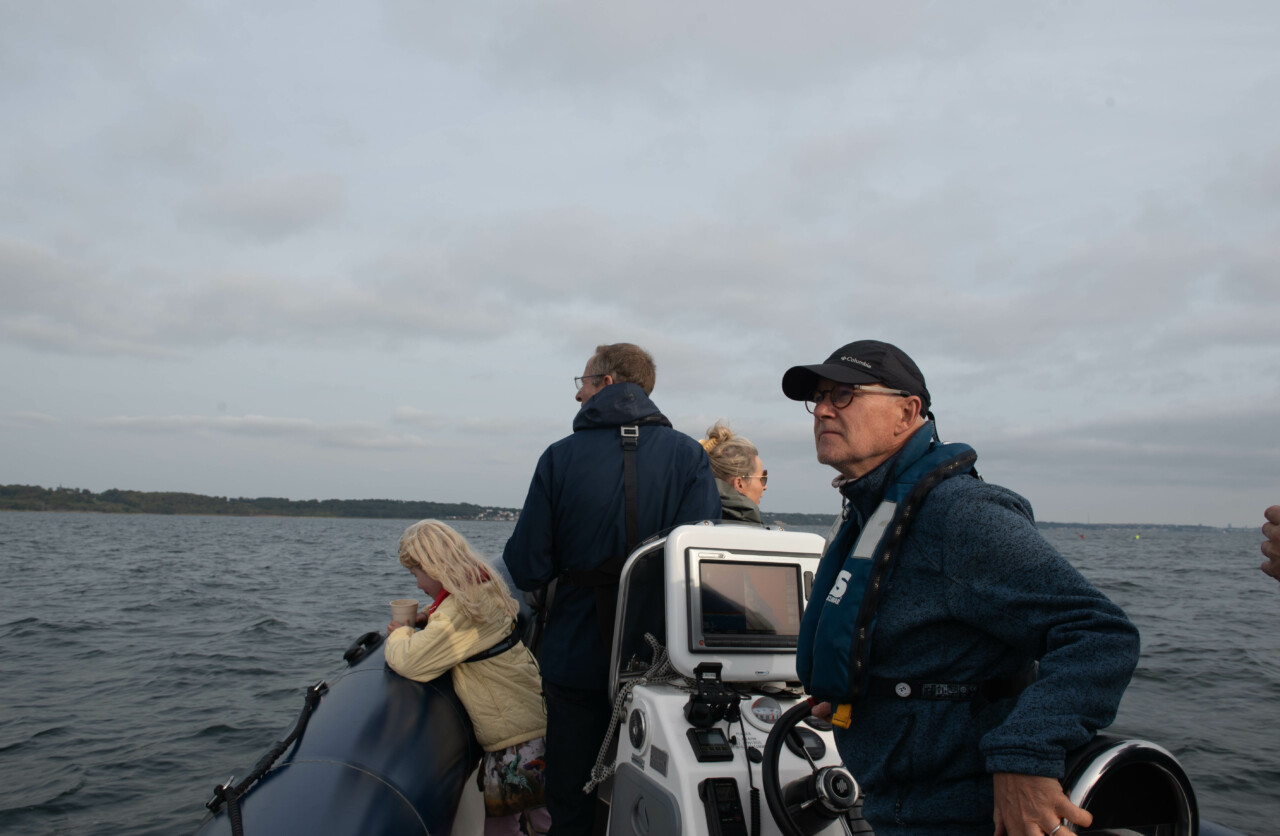Universitetsavisen
Nørregade 10
1165 København K
Tlf: 35 32 28 98 (mon-thurs)
E-mail: uni-avis@adm.ku.dk
—
Campus
Safari — Once threatened with closure, the University of Copenhagen's aquarium unit in Helsingør is now a popular favourite. Everyone wants to sail out on to the Øresund to see the monster-sized tunas jumping around. The University Post was on a tuna safari.
The conditions are just right.
It is about 20 degrees Celsius, slightly cloudy, and the sea current in the Øresund is apparently getting just the right nudge from the wind.
Today’s sailing trip has nine participants, lined up on a small rigid inflatable belonging to the Øresund Aquarium in Helsingør. It will shortly sail us out onto the straights to scout for the area’s big attraction:
Huge, leaping tuna fish.
The boat skims across the water shortly after. You have to cling on to the boat’s rope and grips to not fly off. One little girl screams, most of the others laugh.
For the first long period of time we don’t see any tunas. But while we scout in all directions, our nature guide Catharina Marcussen explains why the tuna are back in the Øresund, after being away for more than 60 years.
»Throughout the 20th century, overfishing resulted in catching all of the large tunas. Around the turn of the millennium, restrictions were therefore placed on tuna fishing worldwide, and a few years ago the larger tunas started to appear again,« the guide says.
Catharina Marcussen explains that the tunas spawn in the Mediterranean, especially around Gibraltar off the coast of Spain. But in the summer the large fish migrate up along the coast of Europe following schools of herring, mackerel and garfish.
»For many years, the tunas haven’t been big enough to be able to make the trip all the way to the Øresund straights, but they are now. The largest can weigh about 400-500 kg,« she says, and the boat’s passengers let out a simultaneous gasp at the thought of encountering a predatory fish of that size.
»They’re big, but they’re not dangerous,« the nature guide assures us. But you can be startled the first time you meet a hunk like that.
»We recently had to help a man in a kayak back to the harbour when he was suddenly surrounded by huge leaping tunas. They didn’t do anything, it was just a bit overwhelming to sit in a kayak in the middle of the water while the tunas flew around his head,« she laughs.
We are instructed to look for seagulls above the water, as they typically go the same places as the tunas and the large white splashes. If you see a tuna, you have to shout out a clock bearing so that the other guests can turn their heads and look in the right direction.
It happens about three times that one of the others shouts »Tuna!« followed by a clock time, while this journalist, of course, is looking in the completely wrong direction. Everyone laughs and talks enthusiastically about the big animals with each other.
This year has been the busiest in the whole history of the aquarium. We have been completely flattened.
Jens Peder Jeppesen, Aquarium Manager, Øresund Aquarium
One of us has seen »half a tail«. Another has seen the whole animal with a garfish in its mouth. A third simply states »wow, that was a big one.«
I still have no idea what they are talking about.
Guests keep on spotting white splashes, and the boat’s captain speeds towards the splash. Everyone grabs for the boat’s ropes and off it goes. On the way, we also meet a lonely seal, and I manage to immortalize the encounter in a picture.
Not so, when I for the first time finally had my head in the right direction when a giant tuna jumps straight up into the air and lands with a giant splash in the water.
I didn’t get it on camera, but I promise: I saw it.
And I confirm: It was a really big one.
The University Post was supposed to have been on a tuna safari last year. But it is not easy to pin the Øresund Aquarium down, with enquiries from Danish media, international nature magazines, and private companies, all hoping to see the cavorting tuna.
A few days after my trip on the Øresund, I catch up with Aquarium Manager Jens Peder Jeppesen over the phone for a follow-up interview.
»Oh, glad you called! I forgot we had an appointment,« he says and quickly apologizes:
»This year has been the busiest in the whole history of the aquarium. We have been completely flattened.«
I suggest we start the interview there: What has happened to the Øresund Aquarium? Back in 2017 it had to fight for its survival, but now it is struggling to keep up with the overwhelming demand?
»It is mostly our tuna safaris in the Øresund that have given a boost to people’s awareness of the aquarium. It went crazy last year when we got a ten minute feature on the national TV news on DR. Everything was just right on the night they went out, the tuna jumping around wildly. There were some amazing images,« says Jens Peder Jeppesen, adding:
»The next day all our tuna safaris were sold out.«
In addition to jumping tunas, several large predators have also been spotted in the Øresund this year. These include a killer whale — and a humpback whale which, like the tuna, follow the large schools of herring and mackerel.
»I think we’ll see far more of these large predators in the Øresund straights. But of course it depends on whether we can avoid catching all the herring and mackerel that attract them. If there are no prey, the predators have no interest in coming here either,« says Jens Peder Jeppesen.
The tuna began to appear in 2017. Back then, the aquarium manager suggested that the Øresund Aquarium start doing tuna safaris. But his colleagues and boss just laughed at him.
So you would transport people out on a boat out on to the straights for hours to see … nothing?
»We ended up doing four tuna safaris in 2017 anyway. No one else bothered to take them, so I had to sail out with the guests myself,« Jens Peder Jeppesen laughs and continues:
»But we ended up seeing tuna on two out of four trips. And from there, the frequency increased as the number of tuna increased. This year we have had a record number of trips – 420 of them,« he says, adding that some sailings end up being cancelled due to the weather.
»The tuna safaris have brought in almost DKK 2 million in income.«
But what is it that has the giant tuna choosing to romp around in precisely the narrow sound between Denmark and Sweden?
There are a number of very random and very fortunate explanations for this, says Jens Peder Jeppesen:
Bottom trawling has been prohibited in the Øresund since 1932. The ban was originally due to the shipping traffic in the area and not as a measure to protect the natural habitat. But it has led to marine life flourishing here rather than similar marine areas in Denmark.
I think we’ll see far more of these large predators in the Øresund straights. But it depends of course on whether we can avoid catching all the herring and mackerel that attract them.
Jens Peder Jeppesen, Aquarium Manager, Øresund Aquarium
Secondly, the currents in the Øresund have specific properties. In the upper layer one current of brackish water runs from south to north from the Baltic, while at the bottom the more saline water flows the other way, from the North Sea and the Kattegat. Between the two currents, a »fantastic dynamic« emerges. According to Jens Peder Jeppesen, this is what provides »the turbo to the phytoplankton« which the prey fish feed on.
READ ALSO: Head aquarist: An octopus with shark tattoos
The third explanation is that the Øresund happens to be on the herring spawning migration route, which runs from the Kattegat through the Øresund and down to the Baltic, and which draws schools of larger fish behind it.
»Everything is connected: The herring would not have been there if there was still bottom trawling, and the tuna would not have arrived if it were not for the herring. So it’s all basically due to the fact that the area has been untouched for many years,« says Jens Peder Jeppesen.
The Øresund Aquarium is a unit under the Department of Biology at the University of Copenhagen (UCPH) and collaborates closely with the department’s marine research unit, which is also located in Helsingør.
The Øresund Aquarium has been almost completely self-financed since it started in 1973. But in 2018 the aquarium was threatened with closure, and was subsequently made a line item on the Danish government budget with DKK 2 million annually in the years 2018-21. This amount has been increased to DKK 3 million for the years 2022-25.
This was after a number of years where the aquarium had hemorraghed funding and had been up for closure. Together with his department head, Jens Peder Jeppesen set up a rescue team that activated the press and a number of politicians who for a whole year spoke in favour of the aquarium’s survival.
»Without this budget subsidy we would not have survived. And now that we have experienced the rush and the huge interest in the Øresund over the past year, we now have a completely different financial situation,« says Jens Peder Jeppesen. He has worked at the Øresund Aquarium for 26 years and he sees the museum’s existence as essential to people’s knowledge of – and understanding of – the sea.
The Øresund is a prime example of how we should treat other marine areas, and it should serve as inspiration not only to Denmark but throughout the world
Jens Peder Jeppesen, Aquarium Manager, Øresund Aquarium
»The sea is out of sight, out of mind. But it’s incredibly important to inform the general public about what’s going on down there and how we take care of it,« he says. The Øresund Aquarium, in addition to the aquarium itself and the safaris on the Øresund, is also a part of something called the Danish schools service and is responsible every year for the education of up to 10,000 schoolchildren.
Jens Peder Jeppesen hopes that by disseminating the story of the Øresund with its thriving marine life to the whole world it can become an example of what happens when you, with a few interventions, can let nature take care of itself.
A decision was made in 2022 that the Øresund, with the Little Belt — the second of the three Danish straights — will be transformed into Denmark’s first marine national park. According to Jens Peder Jeppesen this happened largely due to a major information project from the Øresund Aquarium.
»The Øresund is a prime example of how we should treat other marine areas. And it should serve as inspiration not only to Denmark but throughout the world,« says the aquarium manager.
Back out on the water, two hours have passed. During this time, we have drunk hot cocoa interspersed with the occasional tuna report and some fast speeding across the water.
A guest almost lost his balance once, but it had no effect on his enthusiasm: »No worries, I’m fine!« he shouted, and urged the boat’s skipper to throttle up towards the leaping fish.
By the time the boat sailed back into port, we had spotted about 20 tuna from different distances. The guests all agreed that this was not their last tuna safari.

